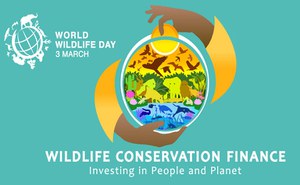World Wildlife Day 2025
March 3, World Wildlife Day, is the day in which we celebrate the conservation of wild flora and fauna
The invention of the concept of "wild" begins to manifest itself in human culture with the domestication of animals and plants. In the Latin etymology of the two words, silva, forest, is contrasted with domus, house, highlighting the meaning and horizon of values that our culture attributes to these two categories. It should be noted that nowadays, in some of the few human populations of hunter gatherers present in very small and remote areas of our planet this distinction is not linguistically present.
World Wildlife Day (WWD), established by the United Nations General Assembly in 2013, celebrates "wild" nature. Global phenomena such as the destruction and fragmentation of habitats, pollution, climate change, the introduction of invasive alien species, poaching and trade of wild species, unsustainable hunting and fishing activities are among the main threats to biodiversity of which wild fauna and flora are an integral part. On March 3, 1973, the Washington Convention (CITES) was signed with the aim of regulating, monitoring and prohibiting the trade of plant and animal species at risk of extinction as well as their products and derivatives.
- https://www.isprambiente.gov.it/en/news/what-are-wild-fauna-and-flora
- World Wildlife Day 2025
- 2025-03-03T00:00:00+01:00
- 2025-03-03T23:59:59+01:00
- March 3, World Wildlife Day , is the day in which we celebrate the conservation of wild flora and fauna The invention of the concept of "wild" begins to manifest itself in human culture with the domestication of animals and plants. In the Latin etymology of the two words, silva, forest, is contrasted with domus, house, highlighting the meaning and horizon of values that our culture attributes to these two categories. It should be noted that nowadays, in some of the few human populations of hunter gatherers present in very small and remote areas of our planet this distinction is not linguistically present. World Wildlife Day (WWD) , established by the United Nations General Assembly in 2013, celebrates "wild" nature. Global phenomena such as the destruction and fragmentation of habitats, pollution, climate change, the introduction of invasive alien species, poaching and trade of wild species, unsustainable hunting and fishing activities are among the main threats to biodiversity of which wild fauna and flora are an integral part. On March 3, 1973, the Washington Convention (CITES) was signed with the aim of regulating, monitoring and prohibiting the trade of plant and animal species at risk of extinction as well as their products and derivatives.
- When Mar 03, 2025 (Europe/Berlin / UTC100)
-
Add event to calendar
iCal
Since its establishment, ISPRA has been the reference body of the Ministry of the Environment and Energy Security for activities to support the correct application of the Washington Convention. Biomolecular analyzes allow us to ascertain the legal possession of specimens of bird, mammal and reptile species that are marketed both on the national territory and in EU or non-EU countries. In 2024, these activities involved the verification of parental relationships (father-mother and offspring kinship tests) in approximately 1300 biological samples concerning 272 families of 53 different CITES species (mainly Psittaciformes, Strigiformes, Falconiformes and terrestrial tortoises) present in Italian farms.
As part of its institutional mandate, ISPRA carries out lines of activity that have as their objective the conservation of wild fauna and flora. To carry out this task, which requires very diversified skills - from ecology, zoology, veterinary, genetics, botany, biogeography and conservation biology - it makes use on the one hand of a continuous comparison with the scientific community for the production and exchange of reliable, verifiable and public data, and on the other hand of a constant dialogue also with central and territorial bodies (regions, autonomous provinces, parks) to better understand the specific contexts, with the aim of providing the best support for the choices of decision makers.

